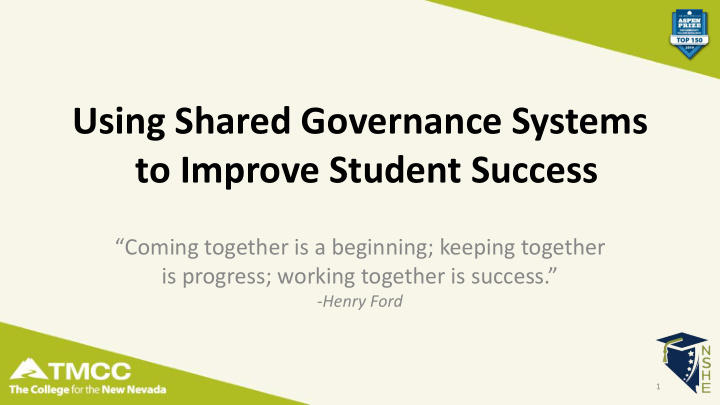



Using Shared Governance Systems to Improve Student Success “Coming together is a beginning; keeping together is progress; working together is success.” -Henry Ford 1
About us ... Regent Carol Del Carlo Nevada System of Higher Education (NSHE) President Karin Hilgersom Truckee Meadows Community College 2
Community colleges have a context ... • Times of disruption – What do you see as causing disruptions in public higher education? 3
What might the future bring? • Rapid changes are occurring in our economy. Such as . . . • What are the challenges facing your college? 4
What is shared governance? • What you said . . . • What it is not . . . – Equal rights on decision making – Faculty way or the highway – Board way or the highway – President’s way or the highway – An obligation that is done to “fake” shared governance 5
What is shared governance? “. . . the goal of shared governance is not consensus but, instead, the best possible decision.” • (Bahls, 2014, pg. 11) 6
Shared governance presumes openness to knowledge • Collaboration can mitigate unintended consequences – The experts are in the field – Board members can inspire change – Presidents can lead from the middle 7
Why does shared governance work? • People support what they help to create • Shared governance can reduce negative unintended consequences of new initiatives (more perspectives on effective implementation) 8
Expanding upon the traditional definition of shared governance (Steven C. Bahls) Commitment to Jointly Culture of Transparency Consider Difficult Issues and and Open Jointly Develop Strategic Communication Directions Shared Governance as a System for Aligning Priorities Set of Checks and Balances to Shared Set of Metrics to Ensure that the Institution Measure Success Remains Mission-Focused Exhibit A . Components of Shared Governance as a System. Adapted from Shared Governance in Times of Change: A Practical Guide for Universities and Colleges (pg 29), by Dr. Steven C. Bahls, 2014, Washington: AGB Press. 9
Effective Shared Governance Defined • Open communication that aligns priorities & creates a culture of shared responsibilities (Bahls, March 8, 2019) 10
What is the role of a board in shared governance? 11
How can linkages between a board, the president’s team, and faculty be strengthened? • Quick partner activity: Engage with the person next to you and brainstorm a strategy to strengthen linkages. You have 2 minutes. • GO! 12
Examples of 3-way information sharing What Can the Board Do? What Can the President Do? What can the CAOs and Faculty Do? Shared Information about how Budgets are Share Board Biographies Share Biographies of Faculty Leaders Built Provide Summaries of Academic Actions Share Board Committee Agendas Share Annual Budgets and Audit Results Taken and Being Considered Provide Summaries of Actions Taken by Provide a One-Page Chart Describing Who Develop and Share a Dashboard of Indicators the Board Makes which Decisions Relevant to Academic Quality Share Basic Information about Board Provide Summaries of Actions Taken by the Share Expected Student Learning Outcomes Structure Cabinet and Actions under Consideration and How Outcomes are Assessed Invite the Board Chair to Speak Annually at a Invite Faculty Leaders to Board Retreats Share President’s Annual Goals and Objectives Faculty Meeting or Retreat Periodically Present to the Board How Involve Faculty Leaders in Board Include Shared Governance at Board, Faculty, Important Academic Decisions (Including Orientations and Staff Orientations Tenure and Promotion) are Made Educate All About Key Directional Documents, Including Strategic Plans Exhibit C . Suggested Practices for Three-Way Information Sharing. Adapted from Shared Governance in Times of Change: A Practical Guide for Universities and Colleges (pg 85), by Dr. Steven C. Bahls, 2014, Washington: AGB Press. 13
The three “T”s and one big “S” • T ransparency • T rust • T alking, talking, and maybe even more talking! • S tructure 14
Shared governance at TMCC and NSHE • What didn’t work at TMCC • Intervention, Three “T”s and one “S” • New model, new culture – Commit to working through difficult issues TOGETHER – Agree on a shared set of metrics for student success TOGETHER – Structure checks and balances to verify and occasionally adjust mission focus 15
Far from perfect, but a good start example: The co-requisite model at TMCC • What did work • What could have been better • Are priorities aligned—Yes! (but it could have been less painful along the way) 16
On the horizon . . . • Using shared governance to share services – Police consolidation model – Sharing platforms that benefit students such as “Starfish” 17
Shared Governance Best Practices: Your key takeaways for this session Consistently and publicly remind all constituencies about the importance of shared governance. Periodically assess the state of shared governance; then develop an action plan to improve it. Support programs to strengthen faculty self-governance Maintain a steadfast commitment to three-way transparency and frequent communication Respect traditional rules of faculty engagement Exhibit B . Shared Governance Best Practices. Adapted from Shared Governance in Times of Change: A Practical Guide for Universities and Colleges (pg 79), by Dr. Steven C. Bahls, 2014, Washington: AGB Press. 18
Questions? 19
Recommend
More recommend